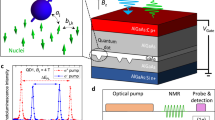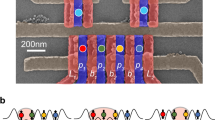Abstract
The spin of a confined electron, when oriented originally in some direction, will lose memory of that orientation after some time. Physical mechanisms leading to this relaxation of spin memory typically involve either coupling of the electron spin to its orbital motion or to nuclear spins1,2,3,4,5,6,7. Relaxation of confined electron spin has been previously measured only for Zeeman or exchange split spin states, where spin-orbit effects dominate relaxation8,9,10; spin flips due to nuclei have been observed in optical spectroscopy studies11. Using an isolated GaAs double quantum dot defined by electrostatic gates and direct time domain measurements, we investigate in detail spin relaxation for arbitrary splitting of spin states. Here we show that electron spin flips are dominated by nuclear interactions and are slowed by several orders of magnitude when a magnetic field of a few millitesla is applied. These results have significant implications for spin-based information processing12.
This is a preview of subscription content, access via your institution
Access options
Subscribe to this journal
Receive 51 print issues and online access
$199.00 per year
only $3.90 per issue
Buy this article
- Purchase on Springer Link
- Instant access to full article PDF
Prices may be subject to local taxes which are calculated during checkout




Similar content being viewed by others
References
Khaetskii, A. V. & Nazarov, Y. V. Spin relaxation in semiconductor quantum dots. Phys. Rev. B 61, 12639–12642 (2000)
Erlingsson, S. I., Nazarov, Y. V. & Fal'ko, V. I. Nucleus-mediated spin-flip transitions in GaAs quantum dots. Phys. Rev. B 64, 195306 (2001)
Khaetskii, A. V., Loss, D. & Glazman, L. Electron spin decoherence in quantum dots due to interaction with nuclei. Phys. Rev. Lett. 88, 186802 (2002)
Merkulov, I. A., Efros, Al. L. & Rosen, M. Electron spin relaxation by nuclei in semiconductor quantum dots. Phys. Rev. B 65, 205309 (2002)
de Sousa, R. & Das Sarma, S. Theory of nuclear-induced spectral diffusion: Spin decoherence of phosphorus donors in Si and GaAs quantum dots. Phys. Rev. B 68, 115322 (2003)
Coish, W. A. & Loss, D. Hyperfine interaction in a quantum dot: Non-Markovian electron spin dynamics. Phys. Rev. B 70, 195340 (2004)
Golovach, V. N., Khaetskii, A. & Loss, D. Phonon-induced decay of the electron spin in quantum dots. Phys. Rev. Lett. 93, 016601 (2004)
Fujisawa, T., Austing, D. G., Tokura, Y., Hirayama, Y. & Tarucha, S. Allowed and forbidden transitions in artificial hydrogen and helium atoms. Nature 419, 278–281 (2002)
Elzerman, J. M. et al. Single-shot readout of an individual electron spin in a quantum dot. Nature 430, 431–435 (2004)
Kroutvar, M. et al. Optically programmable electron spin memory using semiconductor quantum dots. Nature 432, 81–84 (2004)
Bracker, A. S. et al. Optical pumping of the electronic and nuclear spin of single charge-tunable quantum dots. Phys. Rev. Lett. 94, 047402 (2005)
Loss, D. & DiVincenzo, D. P. Quantum computation with quantum dots. Phys. Rev. A. 57, 120–126 (1998)
Wald, K. R., Kouwenhoven, L. P., McEuen, P. L., Van der Vaart, N. C. & Foxon, C. T. Local dynamic nuclear polarization using quantum point contacts. Phys. Rev. Lett. 73, 1011–1014 (1994)
Salis, G. Optical manipulation of nuclear spin by a two-dimensional electron gas. Phys. Rev. Lett. 86, 2677–2680 (2001)
Kumada, N., Muraki, K., Hashimoto, K. & Hirayama, Y. Spin degree of freedom in the ν = 1 bilayer electron system investigated via nuclear spin relaxation. Phys. Rev. Lett. 94, 096802 (2005)
Smet, J. H. et al. Gate-voltage control of spin interactions between electrons and nuclei in a semiconductor. Nature 415, 281–286 (2002)
Ono, K. & Tarucha, S. Nuclear-spin-induced oscillatory current in spin-blockaded quantum dots. Phys. Rev. Lett. 92, 256803 (2004)
Bracker, A. S. et al. Optical pumping of the electronic and nuclear spin of single charge-tunable quantum dots. Phys. Rev. Lett. 94, 047402 (2005)
Petta, J. R. et al. Pulsed gate measurements of the singlet-triplet relaxation time in a two-electron double quantum dot. Preprint at http://arxiv.org/abs/cond-mat/0412048 2004.
Ashoori, R. C. et al. N-electron ground-state energies of a quantum-dot in a magnetic field. Phys. Rev. Lett. 71, 613–616 (1993)
Field, M. et al. Measurements of Coulomb blockade with a non-invasive voltage probe. Phys. Rev. Lett. 70, 1311–1314 (1993)
DiCarlo, L. et al. Differential charge sensing and charge delocalization in a tunable double quantum dot. Phys. Rev. Lett. 92, 226801 (2004)
Elzerman, J. M. et al. Few-electron quantum dot circuit with integrated charge readout. Phys. Rev. B 67, 161308 (2003)
Petta, J. R., Johnson, A. C., Marcus, C. M., Hanson, M. P. & Gossard, A. C. Manipulation of a single charge in a double quantum dot. Phys. Rev. Lett. 93, 186802 (2004)
Ono, K., Austing, D. G., Tokura, Y. & Tarucha, S. Current rectification by Pauli exclusion in a weakly coupled double quantum dot system. Science 297, 1313–1317 (2002)
Johnson, A. C., Petta, J. R., Marcus, C. M., Hanson, M. P. & Gossard, A. C. Singlet-triplet spin blockade and charge sensing in a few-electron double quantum dot. Preprint at http://arxiv.org/abs/cond-mat/0410679 2004.
Paget, D., Lampel, G., Sapoval, B. & Safarov, V. I. Low field electron-nuclear spin coupling in gallium-arsenide under optical-pumping conditions. Phys. Rev. B 15, 5780–5796 (1977)
Dobers, M., von Klitzing, K., Schneider, J., Weimann, G. & Ploog, K. Electrical detection of nuclear magnetic-resonance in GaAs-AlxGa1-xAs heterostructures. Phys. Rev. Lett. 61, 1650–1653 (1988)
Fujisawa, T. et al. Spontaneous emission spectrum in double quantum dot devices. Science 282, 932–935 (1998)
Das Sarma, S., de Sousa, R., Hu, X. & Koiller, B. Spin quantum computation in silicon nanostructures. Solid State Commun. 133, 737–746 (2005)
Acknowledgements
We thank H. A. Engel and P. Zoller for discussions. This work was supported by the ARO, the DARPA-QuIST programme, and the NSF, including the Harvard NSEC.
Author information
Authors and Affiliations
Corresponding author
Ethics declarations
Competing interests
Reprints and permissions information is available at npg.nature.com/reprintsandpermissions. The authors declare no competing financial interests.
Supplementary information
Supplementary Methods
This section contains three parts. The first describes technical details of our experiment, the second discusses the effective nuclear field, and the third expands the theory leading up to equations (1) and (2) in the main text. (PDF 181 kb)
Rights and permissions
About this article
Cite this article
Johnson, A., Petta, J., Taylor, J. et al. Triplet–singlet spin relaxation via nuclei in a double quantum dot. Nature 435, 925–928 (2005). https://doi.org/10.1038/nature03815
Received:
Accepted:
Published:
Issue Date:
DOI: https://doi.org/10.1038/nature03815
This article is cited by
-
Long-lived valley states in bilayer graphene quantum dots
Nature Physics (2024)
-
Wigner-molecularization-enabled dynamic nuclear polarization
Nature Communications (2023)
-
Review of performance metrics of spin qubits in gated semiconducting nanostructures
Nature Reviews Physics (2022)
-
Robust energy-selective tunneling readout of singlet-triplet qubits under large magnetic field gradient
npj Quantum Information (2020)
-
A silicon quantum-dot-coupled nuclear spin qubit
Nature Nanotechnology (2020)
Comments
By submitting a comment you agree to abide by our Terms and Community Guidelines. If you find something abusive or that does not comply with our terms or guidelines please flag it as inappropriate.



